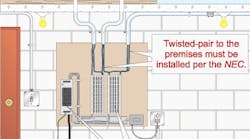All Code references are based on the 2005 NEC. The grounding and bonding requirements in this column apply to solidly grounded systems that operate at not more than 600V, including 120/240V, 120/208V, and 277/480V.
It's late Friday afternoon, and you're looking forward to the weekend, imagining what you'll be doing in just about an hour. Then suddenly the ringing of your cell phone jars you back to reality. After a brief conversation, you know you can forget about your weekend. If smoke pouring out of the server room wasn't bad enough, the news that Frank is on his way to the hospital after simply touching a communication cable has your stomach in knots.
Although no one wants to be stuck in this kind of situation, many facilities, including office, home, and residential, contain NEC Chapter 8 violations that could result in this exact scenario — or worse.
NEC Chapter 8. Some years ago, Sprint changed installation requirements to mandate bonding its ground rod to the main bonding jumper. (Randy Schmisny, former chair of the IEEE Kansas City Section, helped bring this change about.) Sprint's previous stance was that its ground rod should be “separate from” the power ground rod.
This new policy made its installations comply with Art. 250 and Chapter 8. The impetus wasn't pressure to comply with the NEC, but rather the need to prevent equipment failures and reduce service calls. Bonding its electrode to the rest of the system provided cost savings through increased reliability, performance, and safety. Comply with NEC Chapter 8, and you can enjoy those same benefits.
NEC Chapter 8 contains the requirements for communications circuits (Art. 800), Radio and Television Equipment (Art. 810), Community Antenna Television (CATV) and Radio Distribution Systems (Art. 820), and Network-Powered Broadband (Art. 830). From a grounding and bonding standpoint, these Articles have the same goals — the primary one being to eliminate differences in potential. The grounding and bonding rules in these Articles often differ in the details. For example, you'll find differences in the minimum conductor size and whether or not you need an insulated grounding conductor.
Where we get twisted. The telco typically provides the twisted-pair cable to a terminal board at the structure. This terminal board is the network interface device (NID). Art. 800 addresses twisted-pair wiring from the NID to the premises (Fig. 1). We find this kind of wiring in such central station systems as fire and burglar alarm, telephone, and telegraph.
A primary protector is a device that protects installers and occupants from electric shock. You need a listed primary protector for each incoming communications circuit [800.90(A)]. The point of entrance is where the cable enters the structure or grounded raceway. Install the primary protector as close as practicable to the point of entrance [800.90(B)] to reduce differences in potential between communications circuits and other metallic systems and objects. Those differences create personnel hazards and can lead to catastrophic failures — especially when lightning is present.
If you're installing phone cable, ground the metallic sheath (or interrupt it by an insulating joint) as close as practicable to the point of entrance [800.100]. This rule applies to other types of cable covered by Arts. 810, 820, and 830.
Four other rules also apply universally:
-
Keep grounding wires as short as practicable, and run them in a straight line. Why does this matter? Lightning tends not to travel through sharp bends, corners, and loops. Instead, it tends to jump across them or flash over to something nearby.
-
As common sense suggests, you must protect the grounding conductor where it is subject to physical damage — and that typically means you run it in a raceway. If you use a metal raceway, bond each end of the raceway to the grounding conductor.
-
Ground cables and metallic raceways as close as practicable to the entrance point.
-
Use only grounding conductors, connectors, and fittings listed as suitable for the purpose.
Grounding conductor. Art. 800 requirements for grounding the phone cable and the primary protector are nearly identical to those of the other Chapter 8 Articles. The grounding conductor [800.100(A)] must be:
-
Insulated and listed as suitable for the purpose (Art. 810 does not require insulation).
-
Copper or other corrosion-resistant conductive material (Art. 810 has more stringent requirements).
-
Not smaller than 14 AWG (this differs in the other Articles).
-
As short as practicable. In 100(A), Arts. 800, 820, and 830 contain a length limit of 20 feet for dwelling units. Art. 810 does not contain a length limit.
Sometimes, it isn't practicable to limit the grounding conductor to 20 feet Note the exception in 100(A)(4) of the appropriate Article. The details differ slightly, but essentially you can drive a separate ground rod that you must bond back to the grounding conductor.
Though the details differ among the Articles, the requirement to bond all external (entering a structure) systems (e.g., communications and power) to a single point remains. This practice minimizes the possibility of equipment damage — and electric shock — due to differences of potential between the systems (Fig. 2). If you don't make this bond, your system will be at risk for flashover, ground loops, power quality problems, and circulating currents. This is why someone can die from shock by merely touching the shield of the network cable on the back of a printer — even though all systems are properly “grounded.” Maybe size doesn't matter, but bonding does.
Communications electrodes. If the structure has a grounding means, you have several grounding conductor termination options. Terminate to the nearest accessible point of the following locations:
-
Grounding electrode system [250.50].
-
Interior metal water piping system, within 5 feet from point of entrance [250.52(A)(1)].
-
Service bonding means [250.94].
-
Metallic service raceway.
-
Service equipment enclosure, or
-
Grounding electrode conductor (or GEC metal enclosure).
In the rare case that the structure lacks a grounding means, install a ground rod not less than 5 feet long and ½ in. in diameter [800.100(B)(2)(2), 830.100(B)(2)(2)]. For 810 and 820 installations, use a 10-foot rod per 250.52, or bond to the grounded structure. Bond this to the grounding electrode system with a minimum 6 AWG conductor.
Article 810. This Article differs markedly from the other Chapter 8 Articles; however, it still requires you to reduce differences in potential. The difference is in the details of how you do that.
For example, you must provide a listed antenna discharge unit for each lead-in conductor from an outdoor antenna [810.20]. It doesn't matter if you locate the discharge unit inside or outside, but you must locate it nearest the point of entrance — and away from combustible material. If the antenna is indoors (e.g., in an attic), you can skip the discharge unit.
Ground the antenna mast and discharge unit per 810.21 (A) through (K) (Fig. 3). This grounding helps prevent voltage surges caused by static discharge or nearby lightning strikes from reaching the center conductor of the lead-in coaxial cable.
Satellite dishes provide additional challenges. Because the dish sits outdoors, wind creates a static charge on the antenna and attached cable. This charge can build up until it jumps across an air space — often passing through the electronics inside the low noise block down converter feed horn (LNBF) or receiver.
Manufacturers often mold copper-clad steel or bronze wire (17 AWG) into the jacket of the coaxial cable to eliminate the need for a separate ground wire — which simplifies grounding the satellite dish [810.21(F)(1)].
Avoiding confusion. To avoid Chapter 8 confusion, remember:
-
Grounding and bonding requirements are in the same place in each Article (except for Art. 810, which has its own structure).
-
Make your grounding run short and straight.
-
Focus on eliminating differences in potential.
-
Use the Article for your specific installation.
Any time you work on a communications system, turn to Chapter 8. Bond to equalize potential, but ground to protect from lightning.
This is the final article in this series. If you've read them all, you now understand the difference between grounding and bonding — and the purpose of one vs. the other. By not confusing the two, you can eliminate some common causes of unsafe installations.




